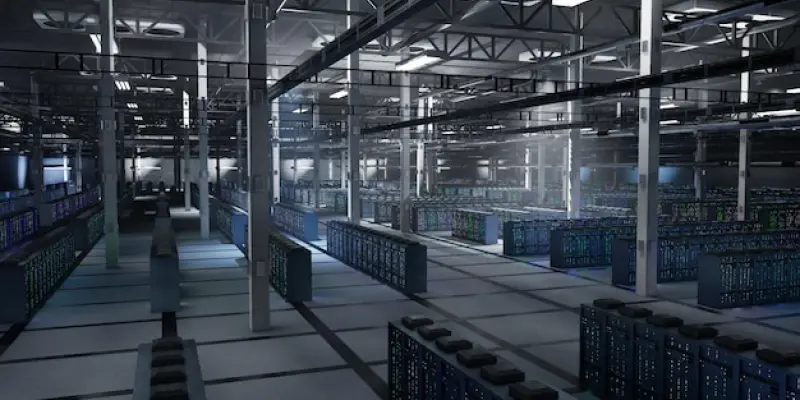The advent of artificial intelligence in the realm of computing has introduced intriguing complexities that continue to shape the design and construction methodologies of modern data centers. As AI technologies gain prominence, the infrastructure required to support them is undergoing transformative changes, particularly concerning weight management. Servers embedded with AI capabilities, featuring cutting-edge GPUs and intricate cooling systems, are imposing unprecedented demands on data center architecture. Consequently, stakeholders are adapting to ensure structural integrity while maintaining efficiency. This article explores how these emerging challenges are influencing data center design, both for new builds and retrofitting existing facilities, highlighting shifts in floor systems and building architecture.
Design Innovations in Ground Floor Systems
Abandonment of Raised Flooring Approaches
The rising physical weight of AI computing equipment forces a reconsideration of conventional raised flooring systems widely employed in data centers. The integration of multiple GPUs, combined with enhanced networking components, results in server racks surpassing traditional weight limits, thus taxing underfloor supports beyond their practical capacity. Operators are increasingly turning to ground slabs, allowing for the accommodation of heavy AI servers without excessively reinforcing elevated floors, a costly endeavor. As reinforced floors become financially unsustainable, the importance of stable ground construction is underscored. Raised floors, while not rendered obsolete, have adjusted roles, often considerably lower than customary standards, mainly serving connections like chilled water piping and cabling.
Development of Single-Story Structures
The construction of single-story data centers emerges as a strategic response to the engineering challenges posed by heavier AI equipment. The industry witnesses a shift from multi-story facilities, driven by the high costs associated with structurally reinforcing upper levels. Simplified single-story designs reduce these costs, providing an economically viable alternative while boosting ease of construction. These choices also reflect advancements in the layout of server placement and cooling systems that necessitate ample and accessible floor plans. The evolving preference for single-story structures marks a pivotal adaptation in embracing AI-driven needs within contemporary data centers. The discourse examines this architectural trend, revealing economic and functional benefits while addressing challenges tied to these configurations.
Reevaluating Existing Data Center Spaces
Retrofits and Structural Assessments
Existing data centers face pressing demands to accommodate the burgeoning weight of AI servers, prompting necessary reevaluations of structural capacities. Operators must conduct comprehensive assessments to determine whether current designs can safely bear the weight without succumbing to stress-related issues. This scrutiny underlines a renewed appeal to brownfield sites, such as unused industrial facilities, whose inherent structural advantages lend themselves to the bolstering of data center architecture. Abandoned factories offer sturdy foundations and potentially accessible power infrastructures, such as substations, presenting a practical solution to meet growing computing requirements. Retrofits at such sites reduce expenses and expedite timelines, ensuring these facilities remain competitive in handling AI needs.
Integration of Power and Cooling Infrastructure
The challenges of upgrading existing data centers for AI revolve around incorporating robust power and cooling solutions while respecting spatial constraints. Many older centers were designed under paradigms driven by less demanding computational and networking needs, lacking the infrastructure to support today’s AI servers’ soaring energy consumption and heat production. Methods to address these issues involve augmenting electrical systems and integrating advanced cooling mechanisms that cater to heightened power influx and thermal output. Such adaptations are imperatively linked to the centers’ ability to sustain efficient operations and maximize uptime. By strategically implementing these upgrades, operators can leverage existing assets effectively, ensuring long-term viability in handling sophisticated AI processes.
Broader Impacts and Future Directions
Shifts in Building Materials and Techniques
Innovative approaches emerge to cope with the weight complexities introduced by AI hardware, including modifications in construction materials and techniques. Reinforced concrete and larger steel beams are utilized to enhance data center resilience, accommodating the significant stresses AI equipment presents. Despite the potentially increased costs, these materials offer the structural support necessary for long-term operational capabilities. Adjustments integrated within regular building schedules ensure minimal disruption while achieving essential design goals, reflecting a commitment to enduring reliability. Such expenditures represent prudent investments in data center longevity, enabling operators to leverage technological advancements without compromising facilities’ structural integrity.
Implications for Industry Adaptation
AI-driven demands necessitate a shift in viewing data centers as dynamic environments that must evolve continuously with technological advancements. The sector’s proactive approach encompasses anticipating infrastructure requirements for devices expected in the future, demanding agility from design and construction practices alike. Operators must contend with ensuring setups that can adapt to enhanced computational capabilities, moving beyond static design conventions. Architects now explore facets once peripheral, like integrating new cooling and power systems or optimizing energy efficiency strategies. The industry remains focused on innovations that sustain AI technology’s progress while minimizing disruptions. The emphasis on proactive solutions underscores a strategic recalibration within data center development paradigms.
Embracing Technological Progress Responsively
In recent discussions, emphasis has been placed on recognizing the impact AI has had on traditional data center frameworks. Adaptive strategies reveal a sector dedicated to evolving infrastructure in tandem with emerging needs, ensuring it remains robust and capable of handling advances in computing technologies. Despite the challenges presented by heavier AI apparatus, these efforts are fundamentally about optimizing environments to facilitate enhanced growth and stability. The architectural transformations discussed offer renewed perspectives on reshaping data center blueprints to achieve long-term viability. As operators anticipate future needs, the progression yields opportunities for expansive development and operational excellence. Furthermore, industry leaders continue to collaborate in overcoming obstacles, fostering innovation, and setting the stage for redefining what constitutes a modern data center.

